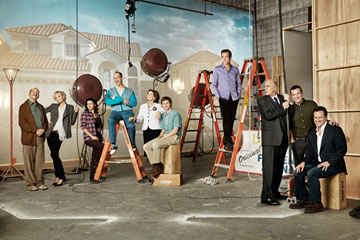
On set with the cast of Arrested Development.
(5 of 6)
If Hurwitz has an ambitious goal here, so does Netflix: to teach all of us to watch TV the way my kids do. At 8 and 11 years old, they've never surfed channels a day in their lives. They have only a vague idea of what a network is. They'd no sooner watch a show by sitting down at a specific time than get dinner by hunting a mammoth. And when they find something they like, they want to watch all of it. Last summer, my youngest son watched the entire seven-season run of Malcolm in the Middle on Netflix.
Netflix's business strategy assumes that children are the future. In a memo accompanying a recent (and quite robust) quarterly earnings report, Hastings predicted that "apps will replace channels, remote controls will disappear and screens will proliferate." Already, "cord cutters" are dropping cable or satellite to watch TV through iPads or game consoles. The new Aereo service allows subscribers to get broadcast-TV signals over the Internet, threatening the networks' retransmission fees from cable companies. (In response, Fox has threatened that it might consider ditching its local affiliates and become a cable network.) There's speculation that consumer or legal pressure could eventually push some channels to offer individual online subscriptions separate from cable packages. When the Great Unbundling comes, Netflix wants to be one of your must-have conduits for fun.
Think of it like HBO, which also makes its money off subscriptions, not ads, and which was also once primarily in the old-movie business. Series like Sex and the City and The Sopranos gave HBO an identity and made pop-culture junkies feel it was necessary to them. Likewise, House of Cards and Arrested Development give Netflix a cachet that streaming The Karate Kid doesn't. "People don't stop me on the street to tell me how much they love [AMC's] The Walking Dead on Netflix," Sarandos says. "But all they want to talk to me about is House of Cards these days. There's a kind of brand affinity if it's your own content vs. a rerun."
Exactly how well it's working is tricky to measure. Netflix recently hit 29.17 million U.S. subscribers, surpassing HBO's 28.7 million. But for all its precise data, the company won't say how many people have watched House of Cards, beyond selective boasts (e.g., it was Netflix's most watched show in February in every country). Sarandos says you can't make an apples-to-apples comparison of ratings between a show that airs weekly for 13 weeks and a 13-episode season viewers might watch in a day, a weekend or over a year. But networks say Netflix is getting license to inflate its success. John Landgraf, president of cable's FX, told a TV critics' conference last summer, "To say that 20 million users sampled something tells me nothing. They may have watched 30 seconds of it."
It's a fair point, as online TV is giving those users more and more to sample. Hulu "aired" a co-production of the British political satire The Thick of It and now carries two former ABC soap operas. YouTube is reportedly launching a set of paid-subscription channels to go along with its free cat videos. In April, Amazon launched 14 new-series pilots for fans to sample and review: eight raw comedies, free of TV standards-and-practices censors, and a half-dozen kids' shows.
